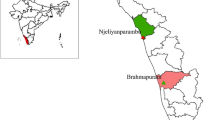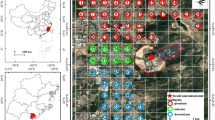Abstract
The application of organic fertilizers has been suspected as an important source of microplastic (MP) pollution in agricultural soils. However, limited data have been reported regarding the quantity and characteristics of MPs in organic fertilizers, giving rise to the difficulties in their risk assessment. This study investigated the occurrence of MPs in 23 commercial organic fertilizers and two farm composts, covering different raw materials and treatment processes. The average MP concentration in the commercial organic fertilizers was 9210.4 ± 1743.1 items/kg, significantly lower than that in farm composts (24344.1 ± 2697.2 items/kg). Among commercial organic fertilizers, the MP loads varied significantly with the source materials and their processing. Organic fertilizers derived solely or proportionally from plant-derived materials through mechanical shredding and sieving had lower MP abundances. The polymer sizes, morphotypes, and colors of MPs in studied samples were mainly < 3 mm, fiber, and black, respectively. The variations in the MP characteristics implied their diverse sources. This study provided a detailed assessment of MP accumulation in organic fertilizers, and confirmed their significance to the MP pollution in terrestrial ecosystem. The results also highlighted the importance of establishing standards to regulate the contents of plastics in raw materials and end products and the treatment processes for the manufacture, thus ensuring the safe application of organic fertilizers.






Similar content being viewed by others
Data availability
The detailed data used in this manuscript is provided in the supplementary information. If further information is required, it will be provided on request.
References
Afonso, S., Arrobas, M., Pereira, E. L., & Rodrigues, M. Â. (2021). Recycling nutrient-rich hop leaves by composting with wheat straw and farmyard manure in suitable mixtures. Journal of Environmental Management, 284, 112105.
Beriot, N., Peek, J., Zornoza, R., Geissen, V., & Huerta Lwanga, E. (2021). Low density-microplastics detected in sheep faeces and soil: A case study from the intensive vegetable farming in Southeast Spain. Science of the Total Environment, 755, 142653.
Bläsing, M., & Amelung, W. (2018). Plastics in soils: Analytical methods and possible sources. Science of the Total Environment, 612, 422–435.
Chen, Y., Leng, Y., Liu, X., & Wang, J. (2020). Microplastic pollution in vegetable farmlands of suburb Wuhan, Central China. Environmental Pollution, 257, 113449.
Cheung, P. K., & Fok, L. (2017). Characterisation of plastic microbeads in facial scrubs and their estimated emissions in Mainland China. Water Research, 122, 53–61.
Du, W., Tang, S., & Wang, H. (2020). The status of organic fertilizer industry and organic fertilizer resources in China. Soil and Fertilizer Sciences in China., 3, 210–219. In Chinese.
FAO (Food and Agriculture Organization of the United Nations). (2019). The international code of conduct for the sustainable use and management of fertilizers (p. 8). Rome.
He, D., Luo, Y., Lu, S., Liu, M., Song, Y., & Lei, L. (2018). Microplastics in soils: Analytical methods, pollution characteristics and ecological risks. Trends in Analytical Chemistry, 109, 163–172.
Hidalgo-Ruz, V., Gutow, L., Thompson, R. C., & Thiel, M. (2012). Microplastics in the marine environment: A review of the methods used for identification and quantification. Environmental Science and Technology, 46, 3060–3075.
Huerta Lwanga, E., Mendoza Vega, J., Ku Quej, V., Chi, Jd. I. A., Sanchez del Cid, L., Chi, C., Escalona Segura, G., Gertsen, H., Salánki, T., van der Ploeg, M., Koelmans, A. A., & Geissen, V. (2017). Field evidence for transfer of plastic debris along a terrestrial food chain. Scientific Reports, 7, 14071.
Hurley, R. R., & Nizzetto, L. (2018). Fate and occurrence of micro(nano)plastics in soils: Knowledge gaps and possible risks. Current Opinion in Environmental Science & Health, 1, 6–11.
Hurley, R. R., Lusher, A. L., Olsen, M., & Nizzetto, L. (2018). Validation of a method for extracting microplastics from complex, organic -rich, environmental matrices. Environmental Science and Technology, 52, 7409–7417.
Imhof, H. K., Laforsch, C., Wiesheu, A. C., Schmid, J., Anger, P. M., Niessner, R., & Ivleva, N. P. (2016). Pigments and plastic in limnetic ecosystems: A qualitative and quantitative study on microparticles of different size classes. Water Research, 96, 64–74.
Lenz, R., Enders, K., Stedmon, C. A., Mackenzie, D. M. A., & Nielsen, T. G. (2015). A critical assessment of visual identification of marine microplastic using Raman spectroscopy for analysis improvement. Marine Pollution Bulletin, 100, 82–91.
Li, X., Chen, L., Mei, Q., Dong, B., Dai, X., Ding, G., & Zeng, E. Y. (2018). Microplastics in sewage sludge from the wastewater treatment plants in China. Water Research, 142, 75–85.
Li, P., Kong, D., Zhang, H., Xu, L., Li, C., Wu, M., Jiao, J., Li, D., Xu, L., Li, H., & Hu, F. (2021). Different regulation of soil structure and resource chemistry under animal- and plant-derived organic fertilizers changed soil bacterial communities. Applied Soil Ecology, 165, 104020.
Liu, H., Wang, Z., Nghiem, L. D., Gao, L., Zamyadi, A., Zhang, Z., Sun, J., & Wang, Q. (2021). Solid-embedded microplastics from sewage sludge to agricultural soils: Detection, occurrence, and impacts. ACS ES&T Water, 1, 1322–1333.
Mahon, A. M., O’Connell, B., Healy, M. G., O’Connor, I., Officer, R., Nash, R., & Morrison, L. (2017). Microplastics in sewage sludge: Effects of treatment. Environmental Science and Technology, 51, 810–818.
MOA (Ministry of Agriculture and Rural Affairs of the People’s Republic of China). (2012). Implementation guidelines for the 2012 soil organic matter enhancement project. Retrieved October 11, 2021, from https://www.moa.gov.cn/govpublic/CWS/201206/t20120606_2751150.htm. Accessed 16 Feb 2024
MOA (Ministry of Agriculture and Rural Affairs of the People’s Republic of China). (2017). Action plan for replacing chemical fertilizer with organic fertilizer for fruit, vegetable and tea. Retrieved October 11, 2021, from https://www.moa.gov.cn/govpublic/ZZYGLS/201702/t20170210_5472878.htm. Accessed 16 Feb 2024
Munno, K., De Frond, H., O’Donnell, B., & Rochman, C. M. (2020). Increasing the accessibility for characterizing microplastics: Introducing new application-based and spectral libraries of plastic particles (SLoPP and SLoPP-E). Analytical Chemistry, 92, 2443–2451.
Nguyen, B., Claveau-Mallet, D., Hernandez, L. M., Xu, E. G., Farner, J. M., & Tufenkji, N. (2019). Separation and analysis of microplastics and nanoplastics in complex environmental samples. Accounts Chem. Res., 52, 858–866.
Nuelle, M.-T., Dekiff, J. H., Remy, D., & Fries, E. (2014). A new analytical approach for monitoring microplastics in marine sediments. Environmental Pollution, 184, 161–169.
Okeke, E. S., Okoye, C. O., Atakpa, E. O., Ita, R. E., Nyaruaba, R., Mgbechidinma, C. L., & Akan, O. D. (2022). Microplastics in agroecosystems-impacts on ecosystem functions and food chain. Resources, Conservation and Recycling, 177, 105961.
Pérez-Guevara, F., Kutralam-Muniasamy, G., & Shrutic, V. C. (2021). Critical review on microplastics in fecal matter: Research progress, analytical methods and future outlook. Science of the Total Environment, 778, 146395.
PlasticsEurope. (2019). Plastics-the facts 2019: An analysis of European plastics production, demand and waste data. Retrieved August 05, 2021, from https://plasticseurope.org/wp-content/uploads/2021/10/2019-Plastics-the-facts.pdf. Accessed 05 Aug 2021
Schymanski, D., Goldbeck, C., Humpf, H.-U., & Fürst, P. (2018). Analysis of microplastics in water by micro-Raman spectroscopy: Release of plastic particles from different packaging into mineral water. Water Research, 129, 154–162.
Song, Y. K., Hong, S. H., Jang, M., Han, G. M., Jung, S. W., & Shim, W. J. (2017). Combined effects of UV exposure duration and mechanical abrasion on microplastic fragmentation by polymer type. Environmental Science and Technology, 51, 4368–4376.
Tian, S., Guo, H., Yao, L., Gong, Z., Dong, L., Bian, W., Luo, J., & Zhang, Y. (2018). Development analysis for fertilizer utilization of agricultural planting and animal wastes in China. Transactions of the Chinese Society of Agricultural Engineering, 34, 123–131. In Chinese.
von Sperber, C., Lewandowski, H., Tamburini, F., Bernasconi, S. M., Amelung, W., & Frossard, E. (2016). Kinetics of enzyme-catalysed oxygen isotope exchange between phosphate and water revealed by Raman spectroscopy. Journal of Raman Spectroscopy, 48, 368–373.
Weithmann, N., Möller, J. N., Löder, M. G. J., Piehl, S., Laforsch, C., & Ruth, F. (2018). Organic fertilizer as a vehicle for the entry of microplastic into the environment. Science Advances, 4, eaap8060.
Yan, Z., Zhao, H., Zhao, Y., Zhu, Q., Qiao, R., Ren, H., & Zhang, Y. (2020). An efficient method for extracting microplastics from feces of different species. Journal of Hazardous Materials, 384, 121489.
Yang, J., Li, R., Zhou, Q., Li, L., Li, Y., Tu, C., Zhao, X., Xiong, K., Christie, P., & Luo, Y. (2021). Abundance and morphology of microplastics in an agricultural soil following long-term repeated application of pig manure. Environmental Pollution, 272, 116928.
Yi, X., Yu, L., Chang, S., Yin, C., Wang, H., & Zhang, Z. (2021). The effects of China’s Organic-Substitute-Chemical-Fertilizer (OSCF) policy on greenhouse vegetable farmers. Journal of Cleaner Production, 297, 126677.
Yu, L., Zhang, J. D., Liu, Y., Chen, L., Tao, S., & Liu, W. X. (2021). Distribution characteristics of microplastics in agricultural soils from the largest vegetable production base in China. Science of the Total Environment, 756, 143860.
Zhang, L., Xie, Y., Liu, J., Zhong, S., Qian, Y., & Gao, P. (2020). An overlooked entry pathway of microplastics into agricultural soils from application of sludge-based fertilizers. Environmental Science and Technology, 54, 4248–4255.
Zhu, D., Chen, Q.-L., An, X.-L., Yang, X.-R., Christie, P., Ke, X., Wu, L.-H., & Zhu, Y.-G. (2018). Exposure of soil collembolans to microplastics perturbs their gut microbiota and alters their isotopic composition. Soil Biology & Biochemistry, 116, 302–310.
Funding
This research was supported by the Natural Science Foundation of China (41877361 and 41811530277) and Natural Science Foundation of Guangdong Province, China (2021A1515011283).
Author information
Authors and Affiliations
Contributions
Jieru Xu, Aiping Yang, Yu Yan, Yuqi Xu, Minyi Tang, Penghui Li: material preparation, data collection, and analysis; Lanfeng Zhao: methodology and validation; Xinming Zhang: revision of the article; Zongling Ren: funding acquisition, conceptualization, and writing the original draft.
Corresponding authors
Ethics declarations
Ethical Approval
Not applicable.
Consent to Participate
Not applicable.
Consent to Publish
Not applicable.
Competing Interests
The authors declare no competing interests.
Additional information
Publisher's Note
Springer Nature remains neutral with regard to jurisdictional claims in published maps and institutional affiliations.
Supplementary Information
Below is the link to the electronic supplementary material.
11270_2024_6977_MOESM1_ESM.docx
Supplementary file1 Detailed information of the recovery test (Tables S1–S2, Figure S1) and the characteristics of MPs (abundance, size distribution, morphotype, color, and polymer type) in each organic fertilizer sample (Tables S3–S5, Figure S2). (DOCX 76553 KB)
Rights and permissions
Springer Nature or its licensor (e.g. a society or other partner) holds exclusive rights to this article under a publishing agreement with the author(s) or other rightsholder(s); author self-archiving of the accepted manuscript version of this article is solely governed by the terms of such publishing agreement and applicable law.
About this article
Cite this article
Xu, J., Yang, A., Yan, Y. et al. Quantification and Identification of Microplastics in Organic Fertilizers: The Implication for the Manufacture and Safe Application. Water Air Soil Pollut 235, 169 (2024). https://doi.org/10.1007/s11270-024-06977-x
Received:
Accepted:
Published:
DOI: https://doi.org/10.1007/s11270-024-06977-x




